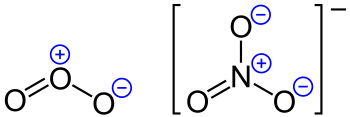
In chemistry, a formal charge (F.C. or q*), in the covalent view of chemical bonding, is the hypothetical charge assigned to an atom in a molecule, assuming that electrons in all chemical bonds are shared equally between atoms, regardless of relative electronegativity.[1][2] In simple terms, formal charge is the difference between the number of valence electrons of an atom in a neutral free state and the number assigned to that atom in a Lewis structure. When determining the best Lewis structure (or predominant resonance structure) for a molecule, the structure is chosen such that the formal charge on each of the atoms is as close to zero as possible.[2]
The formal charge of any atom in a molecule can be calculated by the following equation:
where V is the number of valence electrons of the neutral atom in isolation (in its ground state); L is the number of non-bonding valence electrons assigned to this atom in the Lewis structure of the molecule; and B is the total number of electrons shared in bonds with other atoms in the molecule.[2] It can also be found visually as shown below.
Formal charge and oxidation state both assign a number to each individual atom within a compound; they are compared and contrasted in a section below.
- ^ Hardinger, Steve. "Formal Charges" (PDF). University of California, Los Angeles. Archived from the original (PDF) on 12 March 2016. Retrieved 11 March 2016.
- ^ a b c "Formal Charge". Royal Society of Chemistry. Retrieved 10 December 2021.
